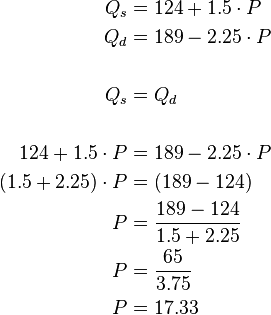Solving For The Competitive Equilibrium Price
To solve for the equilibrium price, one must either plot the supply and demand curves, or solve for their equations being equal.
An example may be:

In the diagram, depicting simple set of supply and demand curves, the quantity demanded and supplied at price P are equal.
At any price above P supply exceeds demand, while at a price below P the quantity demanded exceeds that supplied. In other words, prices where demand and supply are out of balance are termed points of disequilibrium, creating shortages and oversupply. Changes in the conditions of demand or supply will shift the demand or supply curves. This will cause changes in the equilibrium price and quantity in the market.
Consider the following demand and supply schedule:
| Price ($) | Demand | Supply |
|---|---|---|
| 8.00 | 6,000 | 18,000 |
| 7.00 | 8,000 | 16,000 |
| 6.00 | 10,000 | 14,000 |
| 5.00 | 12,000 | 12,000 |
| 4.00 | 14,000 | 10,000 |
| 3.00 | 16,000 | 8,000 |
| 2.00 | 18,000 | 6,000 |
| 1.00 | 20,000 | 4,000 |
- The equilibrium price in the market is $5.00 where demand and supply are equal at 12,000 units
- If the current market price was $3.00 – there would be excess demand for 8,000 units, creating a shortage.
- If the current market price was $8.00 – there would be excess supply of 12,000 units.
When there is a shortage in the market we see that, to correct this disequilibrium, the price of the good will be increased back to a price of $5.00, thus lessening the quantity demanded and increasing the quantity supplied thus that the market is in balance.
When there is an oversupply of a good, such as when price is above $6.00, then we see that producers will decrease the price to increase the quantity demanded for the good, thus eliminating the excess and taking the market back to equilibrium.
Read more about this topic: Economic Equilibrium
Famous quotes containing the words solving for, solving, competitive, equilibrium and/or price:
“If we parents accept that problems are an essential part of life’s challenges, rather than reacting to every problem as if something has gone wrong with universe that’s supposed to be perfect, we can demonstrate serenity and confidence in problem solving for our kids....By telling them that we know they have a problem and we know they can solve it, we can pass on a realistic attitude as well as empower our children with self-confidence and a sense of their own worth.”
—Barbara Coloroso (20th century)
“Certainly, young children can begin to practice making letters and numbers and solving problems, but this should be done without workbooks. Young children need to learn initiative, autonomy, industry, and competence before they learn that answers can be right or wrong.”
—David Elkind (20th century)
“The shift from the perception of the child as innocent to the perception of the child as competent has greatly increased the demands on contemporary children for maturity, for participating in competitive sports, for early academic achievement, and for protecting themselves against adults who might do them harm. While children might be able to cope with any one of those demands taken singly, taken together they often exceed children’s adaptive capacity.”
—David Elkind (20th century)
“That doctrine [of peace at any price] has done more mischief than any I can well recall that have been afloat in this country. It has occasioned more wars than any of the most ruthless conquerors. It has disturbed and nearly destroyed that political equilibrium so necessary to the liberties and the welfare of the world.”
—Benjamin Disraeli (1804–1881)
“The price we pay for the complexity of life is too high. When you think of all the effort you have to put in—telephonic, technological and relational—to alter even the slightest bit of behaviour in this strange world we call social life, you are left pining for the straightforwardness of primitive peoples and their physical work.”
—Jean Baudrillard (b. 1929)